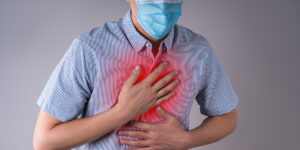Emphysema is a lung disease that causes difficulty in breathing, among other complications over time. Depending on how severe the condition is, early detection and treatment are essential to slow its progression. It is mainly caused by smoking. However, other factors such as passive smoking, inhaling pollutants, and industrial dust can also contribute to its development.
Emphysema is characterized as a chronic obstructive pulmonary disease that roughly affects over 15 million Americans. There are 4 stages of emphysema which doctors differentiate through the GOLD Emphysema Staging System and BODE Index. Symptoms of the disease increase gradually and can eventually lead to lung cancer, pulmonary hypertension, and heart problems. However, its progression can be slowed by an effective treatment plan, although there is no cure for it yet.
This article discusses the 4 stages of emphysema, their symptoms, and treatment for each.
Stage 1 Emphysema: Mild

In the first stage of emphysema, a person experiences mild symptoms such as an ongoing cough with mucus and/or shortness of breath. The symptoms are almost negligible since they rarely cause a problem.
However, the lungs are still damaged even if the symptoms are missed. In case you have a mild cough that persists or feels shortness of breath, it is recommended to visit your doctor and undergo an assessment. If you smoke occasionally, you must stop immediately to prevent the progression of emphysema.
If your doctor diagnoses the beginning of stage 1 emphysema, they might recommend taking a bronchodilator. It is taken through an inhaler, and its main function is to ease breathing by relaxing the airways. However, the use of a bronchodilator can have some side effects. It can cause a runny nose, dry mouth, irritation in the throat, dizziness, and tremors.
In some cases, a person may experience extreme side effects such as an irregular heart rate, blurry vision, swelling, rashes, or developing an allergic reaction. If that happens, you must consult with your doctor immediately.
Respiratory problems can escalate and cause further health complications if not treated timely. You must be vigilant about your health and stay updated with your yearly flu shots and vaccinations.
Stage 2 Emphysema: Moderate

Stage 2 of emphysema is when the symptoms become more noticeable and seeking treatment becomes essential. This is because the airflow starts to become constricted, causing increased coughing, mucus production, and experiencing more than usual shortness of breath during physical activities.
If you previously haven’t noticed your symptoms or didn’t take them seriously, in the moderate stage of emphysema, it is important to seek treatment. Your doctor will prescribe a bronchodilator if they haven’t previously and recommend breathing exercises. Breathing techniques like coordinated breathing and pursed lip breathing can lead to developing an active lifestyle with fewer excursions during physical activity.
Another aspect of treatment for stage 2 emphysema is pulmonary rehabilitation, which entails using tools to manage the condition and improve the quality of life. In pulmonary rehab, a person is given nutritional advice, exercise recommendations, breathing techniques, and coping strategies by healthcare professionals, dietitians, and nurses. In order to determine if pulmonary rehabilitation is suitable for you, it is necessary to consult your doctor.
The severity of the symptoms determines the kind of treatment your doctor will recommend for you and how frequently follow-up is needed. In case of mild symptoms, you may be required to follow up every six months. However, in case of severe symptoms, frequent follow-ups may be necessary.
If your doctor recommends a Ct scan or x-ray for diagnosis then you can visit AQ Modern Diagnostic Imaging
Stage 3: Severe

Stage 3 emphysema is a serious and grave stage in which the lungs are significantly affected. The air sacs become weakened, and their function to transport oxygen and clear carbon dioxide is affected.
Symptoms in the third stage of emphysema are very intense and noticeable. A person may develop a frequent cough that produces thicker mucus. The person also experiences severe shortness of breath during physical activity.
In addition to the previous symptoms, additional problems may appear, which include feeling a tightness in the chest, forgetfulness or feeling confused, experiencing fatigue and weakness, swelling in the feet, ankles, and legs, and developing frequent infections.
Flare-ups in this stage become frequent, and lung function is adversely affected. A person in the third stage of emphysema feels a larger amount of mucus clogging the bronchial tubes. In case of experiencing symptoms of flare-ups, it is essential to seek immediate action.
Signs of flare-ups include increased development of mucus and coughing attacks, having problems sleeping and feeling fatigued, hearing wheezing sounds when breathing, increased breathlessness, and cognitive impairment such as depression, confusion, or forgetfulness.
Flare-ups can be managed through medication, including oral steroids or inhaled corticosteroids. However, it is essential to visit your doctor and have them develop a treatment plan for you. Your doctor may require you to visit every two weeks or every month to monitor the symptoms and keep a check on flare-ups.
Stage 4 Emphysema: Very Severe

The last stage of emphysema is the most critical. The symptoms a person has developed during the past three stages become severe and persistent. Normal breathing becomes difficult for the person, and everyday activities become a hassle due to tightness in the chest and shortness of breath.
Sudden flare-ups in stage 4 can be life-threatening, and hospitalization is common for victims of stage 4 emphysema. Other symptoms that develop in this stage include fast or irregular heartbeat, weight loss, delirium, and pulmonary hypertension.
Severe symptoms in stage 4 emphysema can be treated in various ways. These include pulmonary rehabilitation, supplemental oxygen, and steroids that can be administered intravenously or orally via an inhaler. Taking steroids can have side effects such as muscle weakness, swelling in the mouth or airways, fatigue, weight loss, or developing a risk of pneumonia.
A person with stage 4 emphysema can also experience depression, confusion, anxiety, or memory loss. Another option to control severe symptoms includes lung surgery or lung transplant. However, the eligibility for this depends upon several factors, including lung function test results, a pulmonary rehabilitation program, whether your body is capable of undergoing such a treatment, and if you smoke.
Diagnosis for stages of emphysema
Early detection of emphysema is critical in controlling the symptoms and slowing the progression of the disease. There are various tests that help diagnose emphysema and determine its severity. These include pulmonary function tests (PFTs), which determine how well the lungs are functioning based on airflow rate, lung capacity, and gas exchange.
An arterial blood test is another test to determine the functioning of the lungs. It measures the oxygen and carbon dioxide levels in the blood. Increased levels of carbon dioxide in the blood mean it has become more acidic. This reduces the ability of the lungs to transfer oxygen into the blood.
Certain diagnostic imaging tests can also confirm the stages of emphysema and how serious the condition is. These include a mild emphysema ct scan, emphysema x ray, and Echocardiogram that a reliable diagnostic center like AQ Modern Diagnostic Imaging provides.
Another test to determine the severity of emphysema is a walking test that measures a person’s exercise capacity. The person is made to walk for six minutes to determine their oxygen level, pulse, and blood pressure.
Further tests to determine the functionality of the lungs include cardiopulmonary exercise testing. In this test, doctors determine the heart and lungs’ function before and during exercise.
In Summary
Stage 4 emphysema is the most severe and final stage, which prevents normal lung function. A person experiences low oxygen levels, chronic weakness, and difficulty performing normal life functions.
There is no treatment to cure the disease; however, medication is used to relax the airways and manage the symptoms. If the condition continues to decline, surgery may be recommended to improve the functionality of the lungs.

